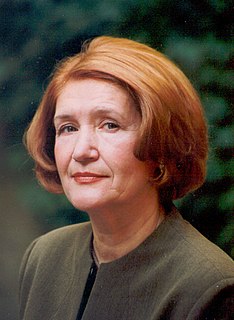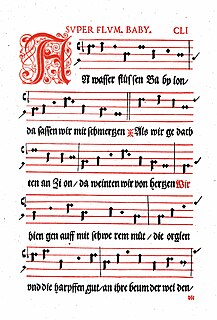
The Hammond organ is an electric organ, invented by Laurens Hammond and John M. Hanert and first manufactured in 1935. Various models have been produced, most of which use sliding drawbars to specify a variety of sounds. Until 1975, Hammond organs generated sound by creating an electric current from rotating a metal tonewheel near an electromagnetic pickup, and then strengthening the signal with an amplifier so it can drive a speaker cabinet. The organ is commonly used with, and associated with, the Leslie speaker.

Bath Abbey is a parish church of the Church of England and former Benedictine monastery in Bath, Somerset, England. Founded in the 7th century, it was reorganised in the 10th century and rebuilt in the 12th and 16th centuries; major restoration work was carried out by Sir George Gilbert Scott in the 1860s. It is one of the largest examples of Perpendicular Gothic architecture in the West Country. The cathedral of the Diocese of Bath and Wells was consolidated to Wells Cathedral in 1539 after the abbey was dissolved in the Dissolution of the Monasteries, but the name of the diocese has remained unchanged.

In music, the organ is a keyboard instrument of one or more pipe divisions or other means for producing tones, each played with its own keyboard, played either with the hands on a keyboard or with the feet using pedals. The organ is a relatively old musical instrument, dating from the time of Ctesibius of Alexandria, who invented the water organ. It was played throughout the Ancient Greek and Ancient Roman world, particularly during races and games. During the early medieval period it spread from the Byzantine Empire, where it continued to be used in secular (non-religious) and imperial court music, to Western Europe, where it gradually assumed a prominent place in the liturgy of the Catholic Church. Subsequently it re-emerged as a secular and recital instrument in the Classical music tradition.

Edward George Power Biggs was a British-born American concert organist and recording artist.

Virgil Keel Fox was an American organist, known especially for his flamboyant "Heavy Organ" concerts of the music of Bach. These events appealed to audiences in the 1970s who were more familiar with rock 'n' roll music and were staged complete with light shows. His many recordings made on the RCA Victor and Capitol labels, mostly in the 1950s and 1960s, have been remastered and re-released on compact disc in recent years. They continue to be widely available in mainstream music stores.

Rodgers Instruments Corporation is an American manufacturer of classical and church organs. Rodgers was incorporated May 1, 1958 in Beaverton, Oregon by founders, Rodgers W. Jenkins and Fred Tinker, employees of Tektronix, Inc., of Portland, Oregon, and members of a Tektronix team developing transistor-based oscillator circuits. Rodgers was the second manufacturer of solid state oscillator-based organs, completing their first instrument in 1958. Other Rodgers innovations in the electronic organ industry include solid-state organ amplifiers (1962), single-contact diode keying (1961), reed switch pedal keying for pedalboards (1961), programmable computer memory pistons (1966), and the first MIDI-supported church organs (1986).

An electric organ, also known as electronic organ, is an electronic keyboard instrument which was derived from the harmonium, pipe organ and theatre organ. Originally designed to imitate their sound, or orchestral sounds, it has since developed into several types of instruments:

A pedalboard is a keyboard played with the feet that is usually used to produce the low-pitched bass line of a piece of music. A pedalboard has long, narrow lever-style keys laid out in the same semitone scalar pattern as a manual keyboard, with longer keys for C, D, E, F, G, A and B, and shorter, higher keys for C♯, D♯, F♯, G♯ and A♯. Training in pedal technique is part of standard organ pedagogy in church music and art music.

The water organ or hydraulic organ is a type of pipe organ blown by air, where the power source pushing the air is derived by water from a natural source or by a manual pump. Consequently, the water organ lacks a bellows, blower, or compressor.

The pump organ is a type of free-reed organ that generates sound as air flows past a vibrating piece of thin metal in a frame. The piece of metal is called a reed. Specific types of pump organ include the reed organ, harmonium, and melodeon.
An organ recital is a concert at which music specially written for the organ is played.

Frederick L. Swann is an American church and concert organist, recording artist, choral conductor, and former president of the American Guild of Organists. Music critic Tim Smith called Swann "one of the country's most distinguished organists". He is Organist Emeritus of the Crystal Cathedral and the First Congregational Church of Los Angeles.

Johann Sebastian Bach was a German composer and musician of the Baroque period. He is known for instrumental compositions such as the Art of Fugue, the Brandenburg Concertos, and the Goldberg Variations, and for vocal music such as the St Matthew Passion and the Mass in B minor. Since the 19th-century Bach Revival he has been generally regarded as one of the greatest composers of the Western art musical canon.

Jevgenija Lisicina also spelled Eugenia Lissitsyna, Jewgenia Lisitzina is a Latvian organist of Russian descent.

Taylor Cameron Carpenter is an American pipe organist. In 2009, he became the first organist to ever be nominated for a Grammy Award for his solo album, Revolutionary. He designed and commissioned the International Touring Organ (ITO), a one-of-a-kind, customized, “full-scale portable organ sonically tailorable to any acoustic environment”, which took ten years and cost $2 million to build. Since its premiere in March 2014, he no longer has to learn a new instrument for every performance which he characterized as maddening, and he now tours worldwide to venues that have never had an organ. The story of the ITO is the subject of the 2015 documentary "The Sound of My Life".
The Organ Historical Society is a not-for-profit organization primarily composed of pipe organ enthusiasts interested in the instrument's design, construction, conservation and use in musical performance. The main activities of the Society include promoting an active interest in the organ and its builders, particularly those in North America, through publishing efforts, national conventions, and preservation of library and archival materials. The Society also actively works to encourage the historic preservation and integrity of noteworthy instruments. Members consider organs in their larger context, and their audiences, builders, case designs, construction, geographical distribution, history, marketing, physical attributes, sound, and voicing receive the emphasis of attention. The society is a ready resource for nonmembers seeking to discover the significance and potential avenues of restoration for instruments in their care. Formed in 1956, the headquarters which had been in Richmond, Virginia for several years, moved to Villanova, Pennsylvania during the week of October 16, 2017.

St. Theresa Church is a Roman Catholic church in Trumbull, Connecticut, a part of the Diocese of Bridgeport. The parish is considered the Mother Church of Trumbull and is the largest in town with over 3,100 parishioner families.

"An Wasserflüssen Babylon" is a Lutheran hymn by Wolfgang Dachstein, which was first published in Strasbourg in 1525. The text of the hymn is a paraphrase of Psalm 137. Its singing tune, which is the best known part of the hymn and Dachstein's best known melody, was popularised as chorale tune of Paul Gerhardt's 17th-century Passion hymn "Ein Lämmlein geht und trägt die Schuld". With this hymn text, Dachstein's tune is included in the Protestant hymnal Evangelisches Gesangbuch.

















